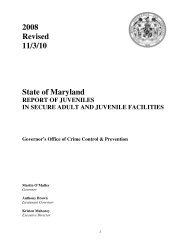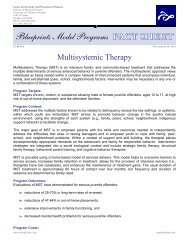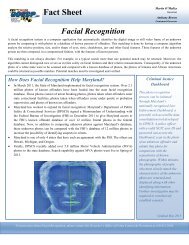Targeted Outreach - Governor's Office of Crime Control & Prevention ...
Targeted Outreach - Governor's Office of Crime Control & Prevention ...
Targeted Outreach - Governor's Office of Crime Control & Prevention ...
You also want an ePaper? Increase the reach of your titles
YUMPU automatically turns print PDFs into web optimized ePapers that Google loves.
58 <strong>Targeted</strong> <strong>Outreach</strong><br />
Many <strong>of</strong> the older youth who are being referred through<br />
the alternative high school housed in the back <strong>of</strong> the Club<br />
had not yet been mainstreamed into the Club at the time<br />
<strong>of</strong> the visit. They use Club facilities (the gym and the computer<br />
room) as part <strong>of</strong> their alternative high school day,<br />
but they are still too “hard core” to integrate into the Club<br />
with the younger kids.<br />
Changes to the Club<br />
The staff identify the needs and interests <strong>of</strong> the kids and<br />
use this information as they develop programs. They do<br />
that with all the kids now, not just the Right Trak youth.<br />
The program has brought community awareness in terms<br />
<strong>of</strong> what the Boys & Girls Club is doing. The Club is now<br />
recognized as more than just a hang out and recreation<br />
center. It is viewed as a youth development center with caring<br />
staff. A probation <strong>of</strong>ficer noted that, before, she would<br />
refer kids and they would go to play and have fun; but,<br />
now with the Right Track program, the Club <strong>of</strong>fers so<br />
much more.<br />
Girls & Boys Club <strong>of</strong> Garden Grove<br />
Goals<br />
One <strong>of</strong> the main goals in implementing GPTTO at the<br />
Club was to encourage staff to start thinking about an<br />
underserved segment <strong>of</strong> the population and then develop<br />
better strategies for serving them. Another goal in implementing<br />
GPTTO was to change the community’s view <strong>of</strong><br />
the Club. The Club leadership was eager to have the<br />
agency known for providing intervention/prevention services<br />
in the community instead <strong>of</strong> being known strictly as a<br />
recreation facility and daycare provider.<br />
Gang Problem<br />
The police <strong>of</strong>ficer with whom we spoke approximated that<br />
there were roughly 2,000 gang members ages 13 to 23 in<br />
the Garden Grove area. Although some are traditional territorial<br />
gangs, primarily Hispanic, there has also been a<br />
huge influx <strong>of</strong> Vietnamese to the community and with that<br />
the police have seen an influx <strong>of</strong> Asian gangs. These Asian<br />
gangs are more likely to be pr<strong>of</strong>it oriented and transitory<br />
(not territorial), are more likely to do well in school and<br />
don’t “hang out” or wear traditional “clothes,” which has<br />
made them harder to identify.<br />
History and Development <strong>of</strong> the Initiative<br />
The Girls and Boys Club <strong>of</strong> Garden Grove had been looked<br />
upon by teachers and social workers primarily as a daycare<br />
center. Prior to initiating the GPTTO program, the club<br />
placed greater emphasis on management and business training<br />
and providing daycare-type services to youth. There was<br />
no emphasis on the one-on-one aspect that GPTTO encourages<br />
and promotes. In the past, staff were not open to listening<br />
to individualized information and therefore, would not<br />
have known about a youth’s particular interests.<br />
Thus, the Club used the GPTTO model to get the Club<br />
directors back in tune with the youth, listening more and<br />
providing opportunities for more hands-on activities. The<br />
idea was to get the staff doing more follow-through in<br />
response to what the teens wanted.<br />
Recruitment and Referral<br />
During the first year <strong>of</strong> implementation, staff reported that<br />
they did not get much response to their efforts at community<br />
mobilization and therefore were not successful in<br />
building an external referral network. They focused instead<br />
on getting parents <strong>of</strong> existing members to refer youth to be<br />
“tracked” and to make sure that their programming was<br />
enhanced to meet the needs and interests <strong>of</strong> the youth.<br />
Club staff also reported referring existing Club members<br />
who were trouble makers, or who showed signs <strong>of</strong> risk for<br />
gangs, such as style <strong>of</strong> dress. Using the GPTTO approach<br />
gave Club staff the tools to provide more individualized<br />
attention to the youth already in the Club.<br />
In the second year <strong>of</strong> implementation, the Club still had<br />
not established a referral relationship with the schools. It<br />
had, however, become the “manager” for the Youth and<br />
Family Counseling Program, a diversion and truancy<br />
reduction initiative housed in the police department<br />
<strong>of</strong>fices. Police <strong>of</strong>ficers refer youth to the Youth and Family<br />
Counseling Program for counseling and to do community<br />
service. The Youth and Family Counseling Program could<br />
potentially refer youth to GPTTO but had not as <strong>of</strong><br />
October 1998 because none <strong>of</strong> the youth had exhibited<br />
risk behaviors for gangs.<br />
Staffing, Intake and Tracking<br />
At the time <strong>of</strong> the site visit, the staffing structure and<br />
process for intake and tracking was in transition. During<br />
the first year <strong>of</strong> the program, the Club director had been<br />
managing the program and the paperwork. The youth<br />
were divided among the staff for tracking. Between the<br />
first and second year <strong>of</strong> implementation, however, the<br />
Club experienced a lot <strong>of</strong> staff turnover as well as promotions<br />
and other internal changes.<br />
Just prior to our visit, the Club had hired a Director <strong>of</strong><br />
<strong>Prevention</strong> Services who would be taking over responsibilities<br />
for GPTTO as well as the other <strong>Prevention</strong> Programs<br />
and services for teens run out <strong>of</strong> all the Clubs. Plans called<br />
for returning to a coordinated sequence <strong>of</strong> intake and<br />
tracking that would involve other Club staff, as well as a<br />
weekly meeting to discuss targeted outreach youth.

















